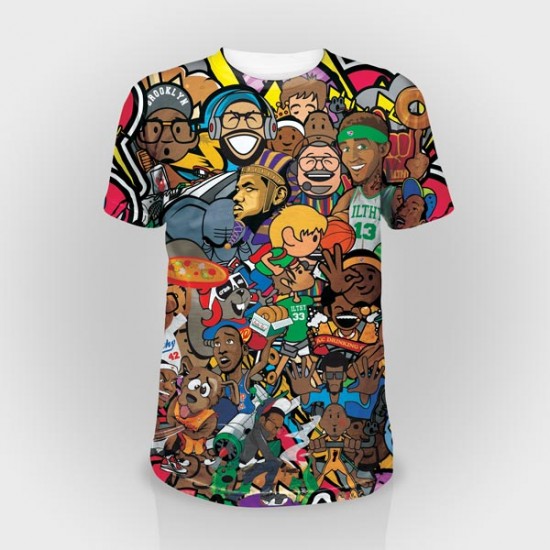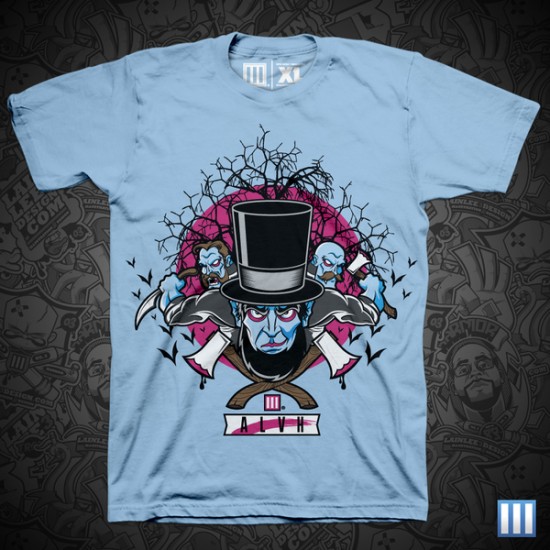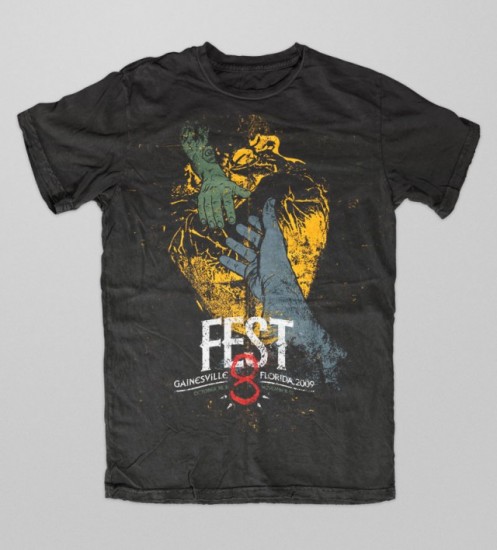Blog

5 Keys to Branding Your Apparel Line Like a Boss (+ 1 Top Secret to a Successful Launch)
How to Brand Your Apparel Line: Keys to Success
“It’s a common misconception that a brand is a company’s logo,” Go Media Partner graphic designer extraordinaire Jeff Finley notes in his book, Thread’s Not Dead. “That’s just part of it. Some experts say that a company’s brand is the “gut feeling” in their audience. The brand is actually a combination of all experiences that a person has with a company. When you think of every interaction as “branding” you can begin to shape the way people feel about your company in a natural way.”
So just how did our favorite clothing brands build their brands and what can you learn from them?
Read on as we talk shop with Jeff and friends Ben Scrivens from popular apparel brand Fright Rags, visual media designer Lain Lee and Hallie Perrin and Chris Miles, both from Cleveland based printing company Jakprints.
Consistency is Key
“The most important thing in branding is consistency. You need consistency in your designs, website, packaging, and social media presence. You need consistency in the way you talk to customers, how you answer the phone, what your email signature says, and the verbiage on your website, etc. The number one thing to remember is you are setting and meeting customer expectations.” – Jeff Finley, Author, Thread’s Not Dead
“It is very important to keep consistency throughout your brand so that the community can recognize it in stores, in the streets, and on social media. My recommendation for keeping this consistency is keeping your logo and the garments you use consistent throughout the merchandise you produce. This helps the community recognize the logo and for the consumer to recognize a high quality product that they love. It will also give them the confidence when purchasing from you.” – Hallie Perrin, Jakprints

“Developing your Mission/Vision Statement in the early stages of planning can help identify who your core demographic is. Staying true to the core values expressed in that document is a sure way to get your customers to identify themselves with your products. Be consistent with these principles when building your brand and you will have longevity in the marketplace.
Fashion is a reflection of our own personal tastes and even the most obscure has a following. Get in touch with those personalities and make them feel like they have a larger sense of community by leveraging social media. By giving them a platform to connect with like-minded individuals, you will gain invaluable advertising through word of mouth. Stick to your ideals and participate in your own forums, with it will come an army of loyal brand patrons.” – Chris Miles, Jakprints

Build a Culture Around your Brand
“It’s all too common for people just starting out to tout themselves as bigger than they are. They use terms like ‘we’ when it’s just one guy in his basement. I did the same exact thing… Ironically, as I really did become a ‘we’ I gravitated to using my own name and identity with my brand. I personalized emails to my customers, and even shot videos of myself talking about how I got into horror and why it means so much to me. Little did I know, I was crafting my story behind our brand and putting a face and voice to the company that customers could relate to. Now I spend a lot of my time cultivating those relationships by doing things like sending surveys, allowing customers to vote on designs, showing them the process of taking a design from sketch to shirt, and even showing them how a shirt is printed.” – Ben Scrivens, Fright Rags
“The first step in building a culture around your brand is to DEFINE the culture you’re seeking to appeal to and develop. A huge mistake a lot of these apparel lines make is not defining their brand – the who, what and why they’re doing it. They start out by making clothes they or their friends want to wear more than anyone else, never really taking the time to do their due diligence and research, making sure that their audience is also looking for what they’re putting out. Without a definition, without a “backstory” to your brand, without understanding the culture you’re seeking to develop around the brand, you’re doomed to just putting designs on clothes (and being stuck with unsold inventory). Building a brand is way too expensive and time consuming to not take the time to define the who, what and why you’re setting out on this journey for.” – Lain Lee, Lain Lee 3 Design
Concentrate on What Makes You Different
“What I believe makes Fright Rags unique is the connection we have to not only the horror genre but to our customers. Everyone who works with us is a fan first. We think like horror fans, and we are active members in the community. Using that as a jumping off point, our sensibilities are already tuned to what other fans might like, which helps guide the types of designs we create. Also, we use original artwork commissioned by artists for our designs. While that is done more and more these days, it was a fairly new thing when we first started as many other companies used poster artwork for their shirts. Our designs are unique artists’ takes on the films we love. Branding is as simple as finding those things you do that sets you apart and honing in on them. It may only be one thing, or a few, but you need to boil it all down to the essentials and build on those. It’s simple – yet also very difficult – because shirt sites are a dime a dozen these days so you have to be very clear with your message or no one will buy from you. In addition, authenticity is also crucial. If you aren’t connected to the types of products you sell in a personal way, it will be much harder to convince others to trust and purchase from you.

I get emails all the time from people who want to create their own brand and they are so fixated on how many designs to release when they start or how many to order for their first run. While those need answering, they are the last things to figure out. If you don’t have customers then it doesn’t matter if you order one shirt or one hundred. What makes you stand out? What is your or your company’s vision? Why would I buy a shirt from you? Answer those questions first, and focus on creating your brand and customer experience around them. The rest will follow.” – Ben Scrivens, Fright Rags
Focus on Customer Service
“Customer service is huge for new clothing lines. The main goal for customer service is to ensure that customer will be be a return customer even if the issue/situation is not in their favor. If that’s a promo code, or an email for them to be the first to know when their out of stock garment is back in stock, it will make that customer feel special and feel like a key asset to that specific clothing line. The possibilities of making that customer feel special are endless, and being resourceful with this is key. – Hallie Perrin, Jakprints
“Customer Service is the key to having repeat customers. If you plan on selling your merchandise online as many independent clothing labels do, be sure to have as much information available about the fit and finish of your garments. You will reduce the amount of returns by simply listing the measurements of each size and by providing a footnotes about the merchandise and models shown on your product pages. When possible, include helpful hints like “sizing runs small”, or “loose fitting”.

Implement Free Shipping and Hassle-Free Returns if possible. By including these costs in your “overhead” before you add markup, online retailers can lower the barrier to entry. Bank on either worst case scenario when building your shipping costs into your pricing or seek out flat-rate mailers to ensure that your operating costs are fixed. 2-way shipping may be too much cost for your product’s price points to absorb, but if on average your customers only return 1 out of every 20 orders then you can build an extra 5% of the shipping fees into your product so that your return will accumulate over time. Be sure to audit the amount of returns vs. the number of shipped orders at least once a year and make adjustments accordingly if necessary.
Last but not least, respond to all comments and complaints promptly. Negative reviews on the internet can be devastating for a company of any size and can be almost impossible to erase from the web. Treat even the most irrational customers with respect and offer them fair resolution, even if it costs you a little extra. The price you pay for “bad press” will far outweigh any spoilage or ruined product that you may have to replace on your own dime. With enough data, this too could be accounted for and added to your operating costs formula.” – Chris Miles, Jakprints
Polarize Your Audience
“It is very important to polarize your brand. Taking a position is what will set you apart. Remaining in the “middle of the road” and trying to appeal to everyone will keep you exactly there – in the middle of the road. If you think of some of the world’s best brands, they always let you know where they stand within their culture and what they represent. Coca Cola, happiness and nostalgia. Apple, quality and innovation. Bad Robot (JJ Abrams production company), mystery and great storytelling. In-N-Out, simple, classic burgers. Remaining marginal will keep you from getting noticed and definitely keep you from standing out in your customers’ minds. To polarize your audience, take a stance and become very vocal about it. If your brand is all about being youthful, fun, and party-hopping, shout it from the mountaintops. If your brand is about clean lines, minimal design, and honoring the spirit of Herman Miller and the Eames, post articles that reflect that mentality and denounce the use of over complicated elements of design. The bottom line, pick a side, then pick a strong subsection of that side, and become very vocal about it’s integral role in your brand.” – Lain Lee, Lain Lee 3 Design

And then…Take it Back to Basics.
“Once you’ve developed your brand, what are the first, most important steps to getting it launched and really seen?,” we asked Lain.
“This is one of my favorite questions that I get asked a lot. And it’s one of my favorites because the answer is the exact opposite of what every article online will tell you. Are you ready?
Make quality, meaningful connections with your audience OFFLINE and use online properties to leverage those relationships. In a world that makes it increasingly easier to connect with people online and never have to touch, talk to, or interact with them, we’ve become way too reliant on the internet and smart phones to handle all of our networking. There is no substitute for shaking someone’s hand and looking them in the eye as you share your passion with them.
People don’t buy your clothes because they’re better than anyone else’s, let’s be honest. Sure, you might have a style that appeals to them. But let’s play a little game really quick: You and another company release the same exact design at the same exact time. You have no followers, you’re just getting started, and you’ve only reached out to your immediate circles through Facebook, Instagram, Twitter and email. The other company is just getting started too, but they’ve decided to release their new design at a local sneaker convention (feel free to substitute in here any other type of convention you’d like).
You hear from a few friends about the shirt, and finally your grandma decides to buy one to support you. They get to spend the next 2 days passing out info, shaking hands with like-minded people, and sharing stories, laughs and making real connections with people about their brand. They end up almost selling out of their design. They get home and see that 52% of the people they handed out cards to have started following them on their social media channels, and their mailing list has grown. They also received several inquiries about what else they had in the works. In this scenario, who do you think made the better decision and why? While you chose to solely rely on social media, the other company went out into the “real world” and made genuine connections with their customers.
So what’s the take home here kiddies?
[Tweet “Customers buy from you because of YOU, not just because of what you’re selling them. – Lain Lee”]
They become invested in your company when you show them why you’re doing it. So in summation – define your brand’s culture, polarize your brand’s ideologies and views, and when making connections with your audience, start with why. (PS: Simon Sinek, a world-renowned author and speaker, has a great video on Youtube in which he explains why you should always “Start with Why” when selling, I highly recommend checking it out.)” – Lain Lee
– So why should we buy your tees? Tell us below! –
_____________________________________________________
More about our contributors:
Jakprints: Facebook | Twitter | YouTube | Google+ | Instagram
Fright Rags: Facebook | Instagram | Tumblr
Jeff Finley: Twitter | Facebook | Dribbble | Pinterest
Lain Lee: Facebook | Twitter | Instagram | Dribbble
_____________________________________________________


